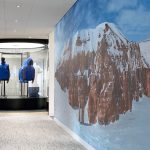VF Corp. expects revenue to grow at a compounded annual growth rate (CAGR) between 4 percent and 6 percent over the next five years, fueled by Vans, North Face and Timberland as well as its international and direct-to-consumer business platforms.
The new long-term outlook comes as VF is hosting a meeting with investors and analysts in Boston, to introduce the company’s 2021 strategic growth plan and key initiatives designed to deliver superior returns to shareholders.
“Our 2021 strategic growth plan fuels our aspiration to consistently grow by creating amazing products and brand experiences that transform and improve the lives of consumers worldwide,” said Steve Rendle, president and chief executive officer. “VF has some of the most beloved and iconic brands in the world and a talented organization that has the passion and commitment to thrive in a rapidly changing marketplace.”
Rendle continued, “The strength and consistency of our largest brands and business platforms give me great confidence in our ability to achieve our targets. We remain sharply focused on our diversified value creation model, which is designed to deliver solid results across the many and varied business cycles and economies around the world.”
2021 Strategic Growth Plan
The 2021 strategic growth plan addresses the quickly changing market landscape with a measurable goal of delivering top quartile total shareholder returns. The five-year plan focuses on four strategic choices that serve as the foundational elements of the new strategy. These choices include: 1) reshaping the company’s brand portfolio and enabling VF’s powerful brands; 2) transforming to a consumer and retail-centric model; 3) elevating direct-to-consumer while prioritizing digital; and, 4) distorting investment toward Asia, with a heightened focus on China. These choices will be enabled by amplified investments and focus on six critical capabilities, including: design and innovation, demand creation and brand experience, insights and analytics, retail excellence, demand and supply chain agility, and talent.
2021 Financial Targets
All forward-looking numbers and growth rates below exclude VF’s Licensed Sports Group given the company’s publicly announced decision in 2016 to explore strategic alternatives for that business.
- Revenue through 2021 is expected to grow at a five-year compounded annual growth rate (CAGR) between 4 percent and 6 percent, fueled by VF’s largest brands (the Vans, The North Face and Timberland brands) and the company’s international and direct-to-consumer business platforms.
- Gross margin is expected to reach 51.5 percent in 2021.
- Operating margin is expected to reach 16.0 percent in 2021.
- Earnings per share is expected to grow at a five-year CAGR of between 10 percent and 12 percent.
- The company expects to generate more than $9 billion of cash from operations on a cumulative basis between 2017 and 2021 and return $8 billion to shareholders through dividends and share repurchases.
- VF expects to deliver annual total shareholder return (TSR) in the 13 percent to 15 percent range as the company continues to target top quartile TSR performance.
Overall, according to its presentation, the sale gains are expected to be more moderate during the “reshape” period in 2017 and 2018 but then expand at a faster rate in the 2018 to 2019 period and accelerate even faster in the 2019-to-2021 period.
At Vans, sales are expected to increase at a CAGR of 8 to 10 percent from 2016 to 2021.
By region for Vans, the CAGR rate over the next five years in the U.S. is expected to be 5 to 7 percent, EMEA, 6 to 8 percent; APAC, 17 to 19 percent; and non-U.S. Americas, 12 to 14 percent. By channel, wholesale for Vans is expected to see a CAGR over the next five years of 3 to 5 percent; DTD (stores), 8 to 10 percent; and DTC (digital) 28 to 30 percent.
Among categories, heritage footwear for Vans is expected to see a CAGR of 3 to 5 percent over the next five years; progression footwear, 12 to 14 percent; and apparel and other, 13 to 15 percent.
North Face expected to see a CAGR of 6 to 8 percent through 2021. Among consumer territories, North Face’s core Mountain Sports area is expected to grow at a CAGR of 4 to 6 percent over the next five years. Five-year CAGR is expected to grow faster in its smaller consumer territories: Mountain Athletics, 11 to 13 percent; Mountain Lifestyle, 8 to 10 percent; and Urban Exploration, 9 to 11 percent.
By region, CAGR growth over the next five for The North Face is expected to be 4 to 6 percent in the U.S., 7 to 9 percent in EMEA, 8 to 10 percent in APAC, and 7 to 9 percent on non-U.S. Americas. By channel, 2 to 4 percent CAGR is expected for wholesale, 7 to 9 for DTC (stores) and 18 to 20 percent DTC (digital.)
At Timberland, sales over the next five years are expected to expand at a CAGR of 4 to 6 percent. By region, CAGR is expected at 3 to 5 percent in the U.S., 4 to 6 percent in EMEA, 6 to 8 percent in APAC, and 8 to 10 percent in non-U.S. Americas.
By channel, sales for Timberland are expected to grow over the next 5 years at a CAGR of 2 to 4 percent at wholesale, 3 to 5 percent at DTC (stores), and 23 to 35 percent at DTC (digital.) By category, men’s is expected to grow at a CAGR from 2016 to 2021 of 3 to 5 percent; women’s, 6 to 8 percent; and apparel and other, 6 to 8 percent.
Fiscal Year End Change
The company’s board of directors has authorized a change in VF’s fiscal year end from the Saturday closest to December 31 of each year to the Saturday closest to March 31 of each year, effective for the fiscal year beginning April 1, 2018. Based on the seasonality and increasing weight of VF’s direct-to-consumer business, the change in fiscal year gives the company greater visibility into projecting revenue growth and planning expenses which will reduce volatility of our results and improve investor communication. The company will report results for fiscal 2017 in February 2018 and, for the three-month transition period of December 31, 2017 through March 31, 2018, in April 2018. The first 12-month fiscal year after the change will run from April 1, 2018 through March 30, 2019.
Share Repurchase Authorization
The company’s Board of Directors also approved a new $5 billion share repurchase authorization. Repurchases under this new program will be made in the open market or pursuant to privately negotiated transactions in compliance with Securities and Exchange Commission Rules, subject to market conditions, applicable legal requirements and other relevant factors. This share repurchase authorization does not obligate the company to acquire any particular amount of its common stock, and it may be suspended at any time at the company’s discretion.
Photo courtesy The North Face















